[無料ダウンロード! √] exocrine pancreas under microscope 732053
Types of Pancreas Tumors Cancer of the pancreas is not one disease As many as ten different tumor types have been lumped under the umbrella term "cancer of the pancreas", classified as exocrine or endocrine tumorsEach of these tumors has a different appearance when examined with a microscope, some require different treatments, and each carries its own unique prognosis Everything can look strange under a microscope, even the human body Below we have put together a list of images of different parts of the human body under the microscope Some have been increased up to 5,000 times!The pancreas contains tissue with an endocrine and exocrine role, and this division is also visible when the pancreas is viewed under a microscope The majority of pancreatic tissue has a digestive role The cells with this role form clusters (Latin acini) around small ducts, and are arranged in lobes that have thin fibrous walls

Regulation Of The Pancreatic Exocrine Differentiation Program And Morphogenesis By Onecut 1 Hnf6 Cellular And Molecular Gastroenterology And Hepatology
Exocrine pancreas under microscope
Exocrine pancreas under microscope-The pancreas is made up of mostly exocrine cells, which makes this type of cancer the most common within the pancreas Biopsy — If an imaging test shows an abnormal area, doctors can perform a biopsy and examine tissue under a microscope to learn whether cancer is present Biopsy results help oncologists plan the best treatment for youWhat are some features of the exocrine pancreas under a microscope sparse stroma (connective tissue) thin capsule delicate connective tissue septa what is the function of the connective tissue septs in the exocrine pancreas divides parenchyma into distinct lobules




Exocrine Pancreas An Overview Sciencedirect Topics
The exocrine portion of the pancreas consists of the pancreatic acini and their ducts The basophilic basal and eosinophilic apical regions seen under the Light microscopic studies of the living acinar pancreas, although limited in number, have revealed valuable information concerning dynamic aspects of microvascular and parenchymal structure and function For example, it has been found that 1) the living organ in anesthetized animals can be imaged with a resolution approaching the limit of the light microscope;In the mouse exocrine pancreas cell under the light microscope They are never found in tissue from animals injected with distilled water Although their detailed structure, as seen with the electron microscope, is so varied, they closely resemble the inclusions identified as neutral red granules in earlier work (Byrne, in press)
The pancreas is both an exocrine accessory digestive organ and a hormone secreting endocrine gland The bulk of the pancreatic tissue is formed by the exocrine component, which consists of many serous pancreatic acini cells These acini synthesize and secrete a variety of enzymes essential to successfully "rest and digest"Within the pancreas, these two functions are performed by different tissues, which can be clearly seen and distinguished from each other when observed under a microscope Most of the cells of the pancreas secrete digestive enzymes (exocrine function) but throughout the organ, there are small sections of cells known as the islets of Langerhans that produce hormones (endocrineExocrine the vast majority of tumors of the pancreas arise in the exocrine part and these cancers look like pancreatic ducts under the microscope These tumors are therefore called "ductal adenocarcinomas," or simply "adenocarcinoma," or even more simply " pancreatic cancer "
Pancreatic Insufficiency & Exocrine Pancreas Dysfunction During a consult when there is a problem with digestion I mentally follow a piece of food from the mouth down the digestive tract to the other end and muscle test each anatomical feature as the food passes Wherever the energy is blocked, my fingers will release letting me know what part of the digestive tract needs work The endocrine pancreas as it is seen under the microscope The endocrine islets are distributed between the exocrine pancreatic tissue and can have a spherical to ovoid, or strungout, form The threadlike arrangement of the epithelial cells and the dense meshwork of capillaries are apparentThis page has endocrine histology of the pancreas under high powerThe pancreas is a mixed gland meaning it has both endocrine and exocrine tissue When look at the pancreas under the microscope you will see numerous pancreatic acini cells that




The Healthy Exocrine Pancreas Contains Preproinsulin Specific Cd8 T Cells That Attack Islets In Type 1 Diabetes



Endocrine Systems Lab
Cells under the microscope – EM 9 2A The exocrine cell contains a lot of rough ER for protein synthesis The content will be secreted with cytoplasmic vesicles and eventually end up in the a blood b digestive tract 2B The alpha cell produces glucagon, which is visible in the dark vesicles Glucagon secretion ensures that the blood sugar levelsIt is possible to distinguish exocrine from endocrine tissue in the pancreas under the light microscope True False True Right after eating a candy bar, insulin secretion would occur True False True Which of the following statement about the pancreas is not true?The cells of the pancreatic acini were pyramidal in shape with large spherical and centrally located heterochromatic nuclei The basophilic basal and eosinophilic apical regions seen under the light microscope showed concentrated rough endoplasmic reticulum and homogenous electron dense zymogen granules, respectively, on ultramicroscopy




Electron Micrograph Of Acinar Cells Of The Exocrine Pancreas Download Scientific Diagram




Exocrine Pancreatic Insufficiency In Dogs Vca Animal Hospital
Examine slide 1 at the lowest power and note that most of the section appears purple or bluish This is the parenchyma (or functional tissue) of the exocrine pancreas You will note that the parenchyma is rather indistinctly divided into smaller areas by slits of open space or by pink connective tissue (stroma)Further, under the microscope, the appearance and arrangement of these carcinoma cells can appear as ductlike (or "adeno") giving the term adenocarcinoma to this most common form of pancreatic cancer About threequarters of exocrine pancreatic cancer arises in the head and neck of the pancreas (the anatomic parts through which theIn the histologic image of an equine pancreas seen below, a single islet is seen in the middle as a large, palestaining cluster of cells All of the surrounding tissue is exocrine Pancreatic exocrine cells are arranged in grapelike clusters called acini (a single one is an acinus)



Functional Anatomy Of The Endocrine Pancreas




Scanning Electron Microscopy Of The Rat Exocrine Pancreas Semantic Scholar
HistoQuarterly PANCREAS Working in a histology lab means that I get to see a lot of what our body looks like under the microscope Quarterly I will share with you some of my photos from the microscopic world of our inner space and tell you a little bit about what we're looking at This quarter I have chosen the pancreas because this organHuman Structure Virtual Microscopy The pancreas is a dual exocrine and endocrine gland The exocrine pancreas is specialized for secretion of digestive enzymes (eg proteinases, lipases, amylases, and nucleases) that are carried by a duct system to the duodenum Small areas of endocrine tissue (the islets of Langerhans) are interspersed amongst the exocrine pancreas andThese are categorized by looking at the cells under a microscope Doctors use this information to understand the expected growth pattern and speed of the cancer and determine the best course of treatment About 93% of all pancreatic tumors develop in the exocrine component of the pancreas, while only 7% develop in the endocrine component



Liver And Pancreas



Electron Microscopic Study Of Changes In Pancreatic Exocrine Secretory Cells In Both Early And Late Stages Of Hypothyroidism Russian Open Medical Journal
In order to examine the behaviour between the exocrine pancreas under the influence of antiratpancreas immune serum produced in rabbits, a 100 ml immune serum is administered once a week over a maximum 26 week period into Wistarrats by intraperitoneal injectionAnswer Acinar cells secrete pancreatic enzymes, centroacinar cells secrete bicarbonate Acinar cells appear more basophilic under the light microscope because of their high RER content and contain many granules under the electron microscope In pancreas histology of animal, you will find the both endocrine and exocrine parts The exocrine part forms the major portion of pancreas and consists of closely packed serous acini with zymogenic cells Again, the endocrine part consists of pancreatic islets of Langerhans which is located within the masses of serous acini




Implications Of Integrated Pancreatic Microcirculation Crosstalk Between Endocrine And Exocrine Compartments Diabetes



Dictionary Normal Pancreas The Human Protein Atlas
Score to assess acute cellular stress in the human exocrine pancreas This is an open access article under the terms of the Creative Commons Attribution License, which permits use, distribution and reproduction in any visualise islets under a dissecting microscope, further dissected into 1–2mm3 biopsies including visibleExocrine pancreatic cancers are the most common type of pancreas cancer Endocrine tumors are more rare and can be benign (not cancerous) or malignant (cancerous) Both tumors can look alike under a microscope, so it isn't always clear if they are really cancer until itIn the exocrine pancreas Given that DHPS catalyzes eIF5A hypusination,1214 and the hypusinated form (eIF5AHYP) functions in mRNA translation,911 we evaluated and uncovered stalled translation elongation concomitant with the differential expression of proteins that influence exocrine pancreas growth and function



1




High Magnification Of A Human Islet Of Royalty Free Stock Photo Avopix Com
Looking at it under a microscope and it looks 'busy' pancreas is an exocrine organ The exocrine function involves producing digestive Pancreas Pancreas under the stomach Pancreas at low scanning power Duct compared to islets The duct has a very small opening and the islets are labeled with an I Under a microscope, stained sections of the pancreas reveal two different types of parenchymal tissue2 Lightly staining clusters of cells are called islets of Langerhans, which produce hormones that underlie the endocrine functions of the pancreas Darker staining cells form acini connected to ductsUsing various routine and special techniques and were examined under Leica DM 00 LED microscope During second month of prenatal development, the exocrine pancreas comprised ductules of varying size dispersed within the mesenchyme of both pancreatic primordia As age advanced and the pancreatic primordia fused, the
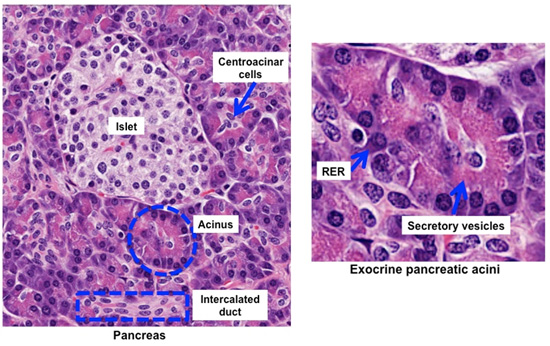



Human Structure Virtual Microscopy




Regulation Of The Pancreatic Exocrine Differentiation Program And Morphogenesis By Onecut 1 Hnf6 Cellular And Molecular Gastroenterology And Hepatology
Pancreas Know the following Islets of Langerhans alpha and beta cells exocrine acinar tissue glucagon produced by alpha cells insulin produced by beta cells Full view of Pancreas Pancreatic islets of Langerhans are small nests of cells, arranged into curvilinear cords, scattered throughout the pancreasLab Content Introduction The term "endocrine" implies secretion into the internal milieu of a multicellular organism In contrast to exocrine tissues, where the secretory products are discharged into the external space the outer surface of the body, mucosal surfaces, duct systems the endocrine organs and cells secrete their products into the vascular systemPancreas 100X The pancreas contains two sets of cells exocrine cells that secrete enzymes via ducts into the intestine, and endocrine cells that secrete hormones into the bloodstream The exocrine cells are small and arranged in spherical secretory units called acini




Pancreas Histology Identifying Features With Labeled Slide Images Anatomylearner The Place To Learn Veterinary Anatomy Online




Pancreas Histology
A brief review of the normal histology of the pancreas, as presented by the URMC Pathology IT ProgramThe pancreatic islets are the exocrine tissue The pancreas produces insulin1 Red blood cells Red blood cells are responsible for transporting oxygen throughout the body 2



Histology Laboratory Manual



1
The architecture of pancreas from organ donors was studied by light and scanning electron microscopy and by wax reconstruction of serial sections It is concluded that the zymogen granulecontaining cells of normal human exocrine pancreas are ar ranged as branching tubules that vary in diameter and curve acutelyBackground During the process of islet isolation, pancreatic enzymes are activated and released, adversely affecting islet survival and function We hypothesize that the exocrine component of pancreases harvested from preweaned juvenile pigs is immature and hence pancreatic tissue from these donors is protected from injury during isolation and prolonged tissue cultureThe pancreas of insulinrequiring diabetics becomes progressively less capable of responding to the stimuli used for testing exocrine pancreatic function Frier, Saunders, Wormsley and Bouchier, 1976 and post mortem the whole gland is found to be shrunken and fibrosed Vertiainen, 1944 Furthermore the exocrine cells closest to the islets




Morphological Histological And Ultrastructural Studies On The Exocrine Pancreas Of Goose Sciencedirect




Pancreas Wikipedia
Comparison of an image under a light microscope, a scanning electron microscope and an transmission electron microscope of 212 picometers Applications Structure an exocrine gland 12A1 Structure and function of organelles within an exocrine cell of the pancreas 12A1 Structure and function of organelles within the palisade mesophyllAnatomy of the Pancreas Under a microscope, stained sections of the pancreas reveal two different types of parenchymal tissue Lightstained clusters of cells are called islets of Langerhans These produce hormones that underlie the endocrine functions of the pancreas The darkstained cells form acini that are connected to ductsEndocrine Pancreas The islets of Langerhans are clumps of secretory cells (up to around 3000) supported by reticulin fibres, and containing numerous fenestrated capillaries There is a delicate capsule around each islet They are paler than the surrounding exocrine cells, as they have less rER These islets do not have an acinar organisation The islet cells are indistinguishable from




Vip Reduction In The Pancreas Of F508del Homozygous Cf Mice And Early Signs Of Cystic Fibrosis Related Diabetes Cfrd Journal Of Cystic Fibrosis
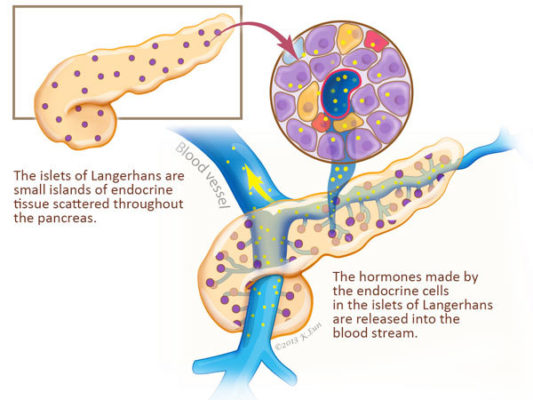



Pancreas Function Pancreatic Cancer Johns Hopkins Pathology



Pancreas Dr Jastrow S Electron Microscopic Atlas




Histology Of The Pancreas Endocrine And Exocrine Youtube




Anatomy And Histology Of The Pancreas Pancreapedia




Large Scale Electron Microscopy Database For Human Type 1 Diabetes Nature Communications




Color Scanning Electron Micrograph Of An Acinar Exocrine Pancreatic Cell Acinar Cells Produce And Excrete Digestive Enzymes To The Small Intestine Via The Pancreatic Ducts Stock Photo Offset




Scanning Electron Microscopy Of The Rat Exocrine Pancreas Semantic Scholar
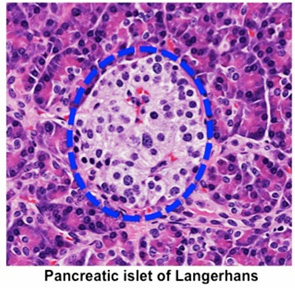



Human Structure Virtual Microscopy




Exocrine And Endocrine Pancreas Light Micrograph Stock Image C036 1331 Science Photo Library
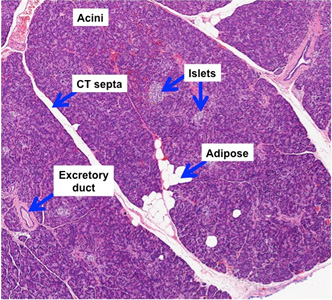



Human Structure Virtual Microscopy



Labeled




Table Table 1 Definitions For Exocrine Pancreas Tnm Stage 0a Pdq Cancer Information Summaries Ncbi Bookshelf




File Pancreas Histology 002 Jpg Embryology




P2ry1 Alk3 Expressing Cells Within The Adult Human Exocrine Pancreas Are Bmp 7 Expandable And Exhibit Progenitor Like Characteristics Cell Reports



Gross And Microscopic Anatomy Of The Pancreas
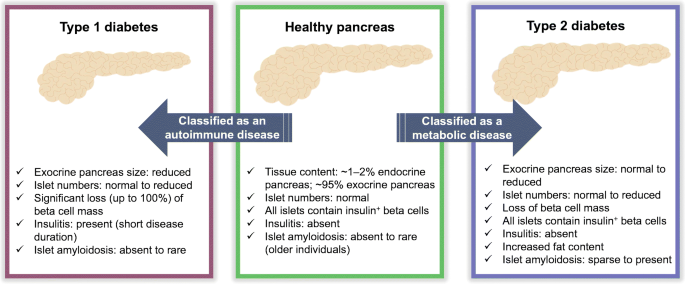



Organisation Of The Human Pancreas In Health And In Diabetes Springerlink



Liver And Pancreas




A Microscopic Section Of Exocrine Pancreatic Adenocarcinoma The Download Scientific Diagram




Profiling Human Islet Cells With Laser Capture Microdissection



Exocrine Pancreas Dr Jastrow S Electron Microscopic Atlas




Anatomy And Histology Of The Pancreas Pancreapedia



Chapter 16 Page 3 Histologyolm



Pancreas 400x




Endocrine Pathology




Exocrine Pancreas An Overview Sciencedirect Topics




Solved 3 Pancreas 1 Pancreatic Acini Exocrine Portion 2 Chegg Com
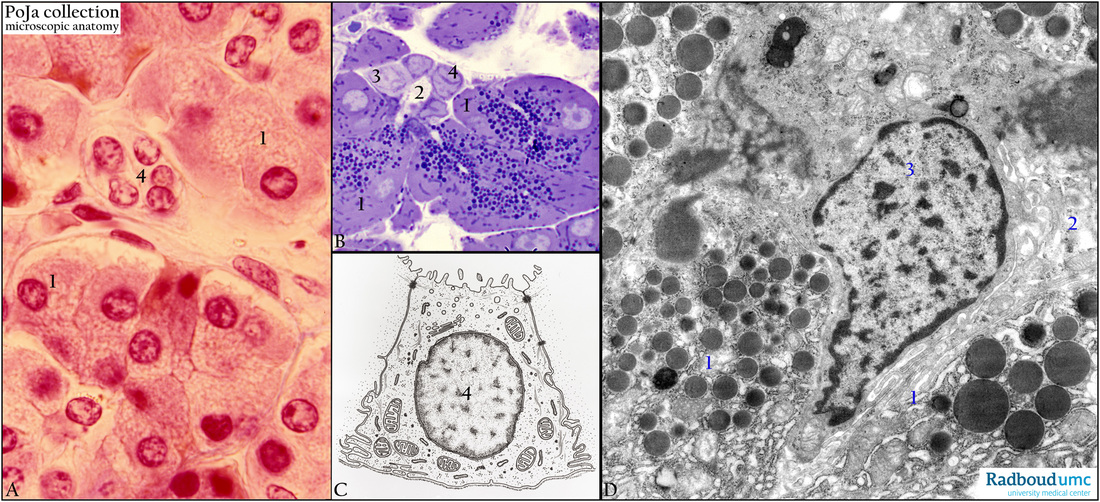



Intercalated Duct Of Exocrine Pancreas Human Rabbit Poja Collection Microscopic Anatomy
:watermark(/images/watermark_only.png,0,0,0):watermark(/images/logo_url.png,-10,-10,0):format(jpeg)/images/anatomy_term/body-of-pancreas-3/mbuhIx2qC3HVaYNH69w_Body_of_Pancreas.png)



Pancreas Histology Exocrine Endocrine Parts Function Kenhub



Pancreatic Histology Exocrine Tissue



Digestive The Histology Guide




What Are Pancreatic Causes Of Exocrine Pancreatic Insufficiency Epi



Objective 4 4c Cytoplasmic Organelles Secretory Granules Em




Men1 Maintains Exocrine Pancreas Homeostasis In Response To Inflammation And Oncogenic Stress Pnas
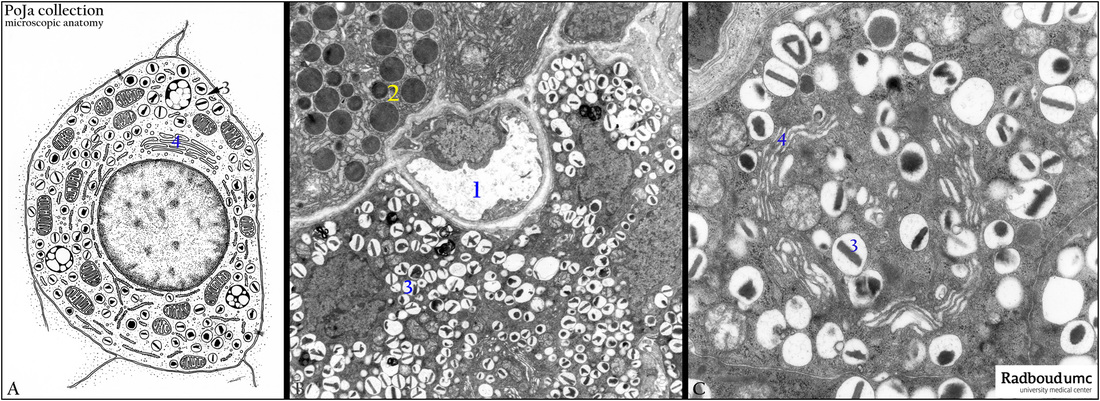



B Cells In Islet Of Langerhans In The Exocrine Pancreas Dog Poja Collection Microscopic Anatomy




Pancreas Histology




The Endocrine And Exocrine Pancreas Cross Section Human P Flickr




Distribution Of Exocrine Portion Of The Pancreas A The Pancreas Is Download Scientific Diagram



Liver And Pancreas




Exocrine Pancreas Sciencedirect




Mixed Exocrine Endocrine Tumor Of The Pancreas Insight Medical Publishing



Electron Microscopic Study Of Changes In Pancreatic Exocrine Secretory Cells In Both Early And Late Stages Of Hypothyroidism Russian Open Medical Journal
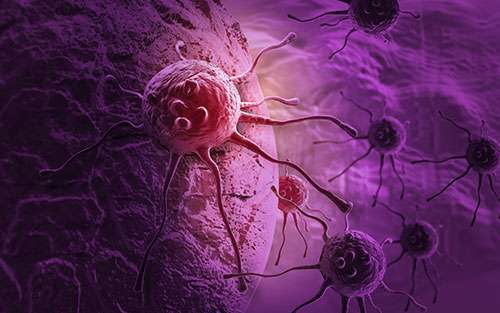



Types Of Pancreatic Cancer Pancreatic Cancer Action Network
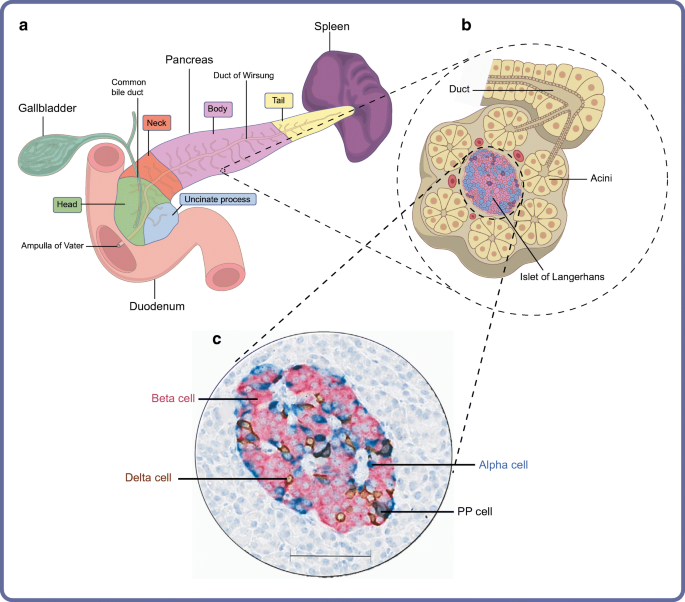



Organisation Of The Human Pancreas In Health And In Diabetes Springerlink



Electron Microscopic Study Of Changes In Pancreatic Exocrine Secretory Cells In Both Early And Late Stages Of Hypothyroidism Russian Open Medical Journal




Anatomy And Histology Of The Pancreas Pancreapedia




Pancreas Wikipedia



Quantitative Characterization Of The Protein Contents Of The Exocrine Pancreatic Acinar Cell By Soft X Ray Microscopy And Advanced Digital Imaging Methods Unt Digital Library




Microscopic Section Of Exocrine Pancreatic Adenocarcinoma Invasion Of Download Scientific Diagram
/exocrine-pancreatic-insufficiency-4177936-821-618578bea845406fa96c78167aff8657.png)



Exocrine Pancreatic Insufficiency Symptoms Causes And Diagnosis




The Roles Of Calcium And Atp In The Physiology And Pathology Of The Exocrine Pancreas Physiological Reviews



Pancreatic Histology Exocrine Tissue




Histoquarterly Pancreas Histology Blog




Histoquarterly Pancreas Histology Blog
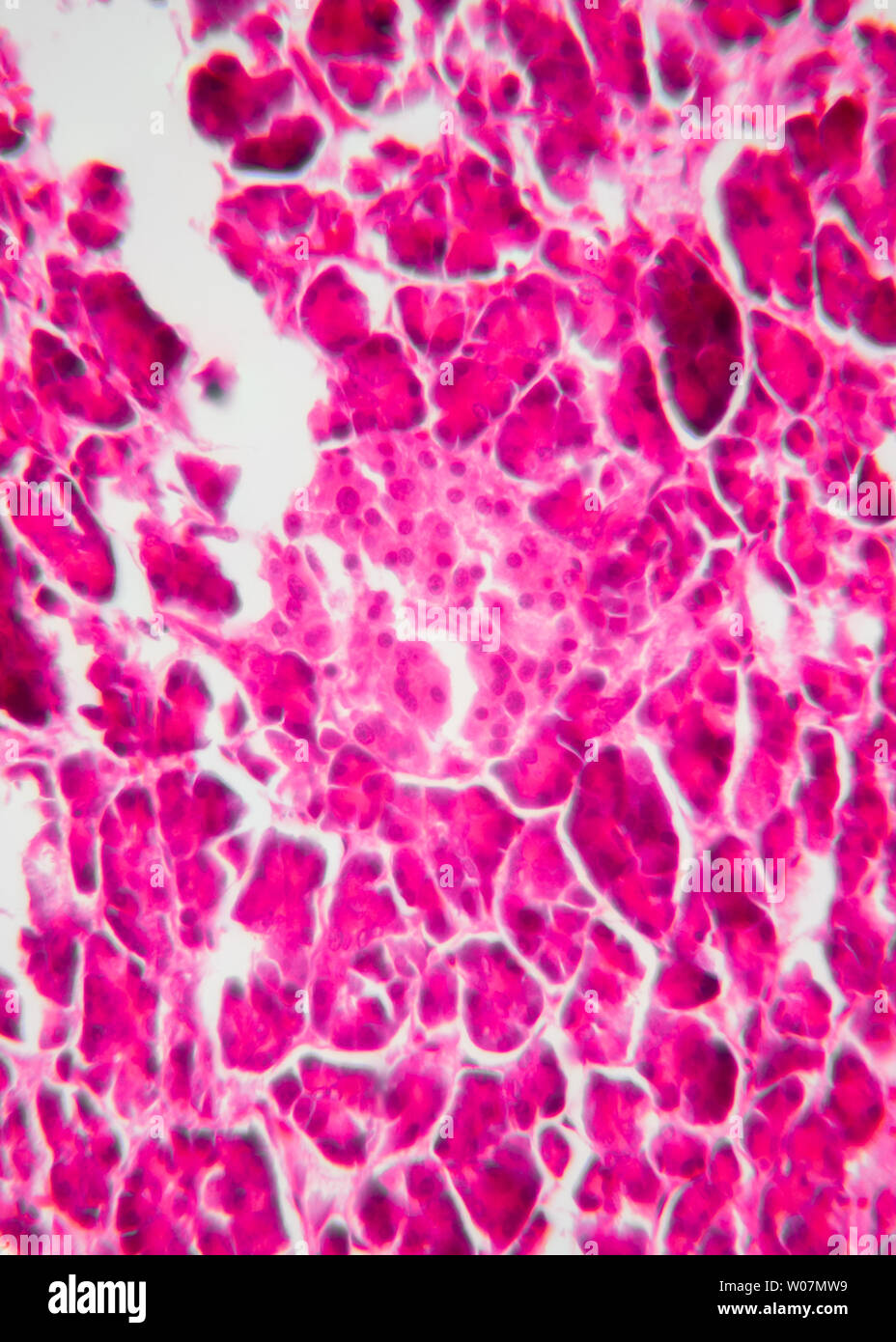



The Endocrine Part Of The Pancreas Islet And The Exocrine Part Magnified By An Optical Microscope 400 Times Shows The Islet Stock Photo Alamy
:watermark(/images/watermark_5000_10percent.png,0,0,0):watermark(/images/logo_url.png,-10,-10,0):format(jpeg)/images/overview_image/1881/CPsIC67xuz6pLt6JhAM6Wg_pancreas-histology_english.jpg)



Pancreas Histology Exocrine Endocrine Parts Function Kenhub




Pancreas Histology Images Stock Photos Vectors Shutterstock




Pancreas Histology




Pancreas Anatomy Functions And Diseases Medical Library
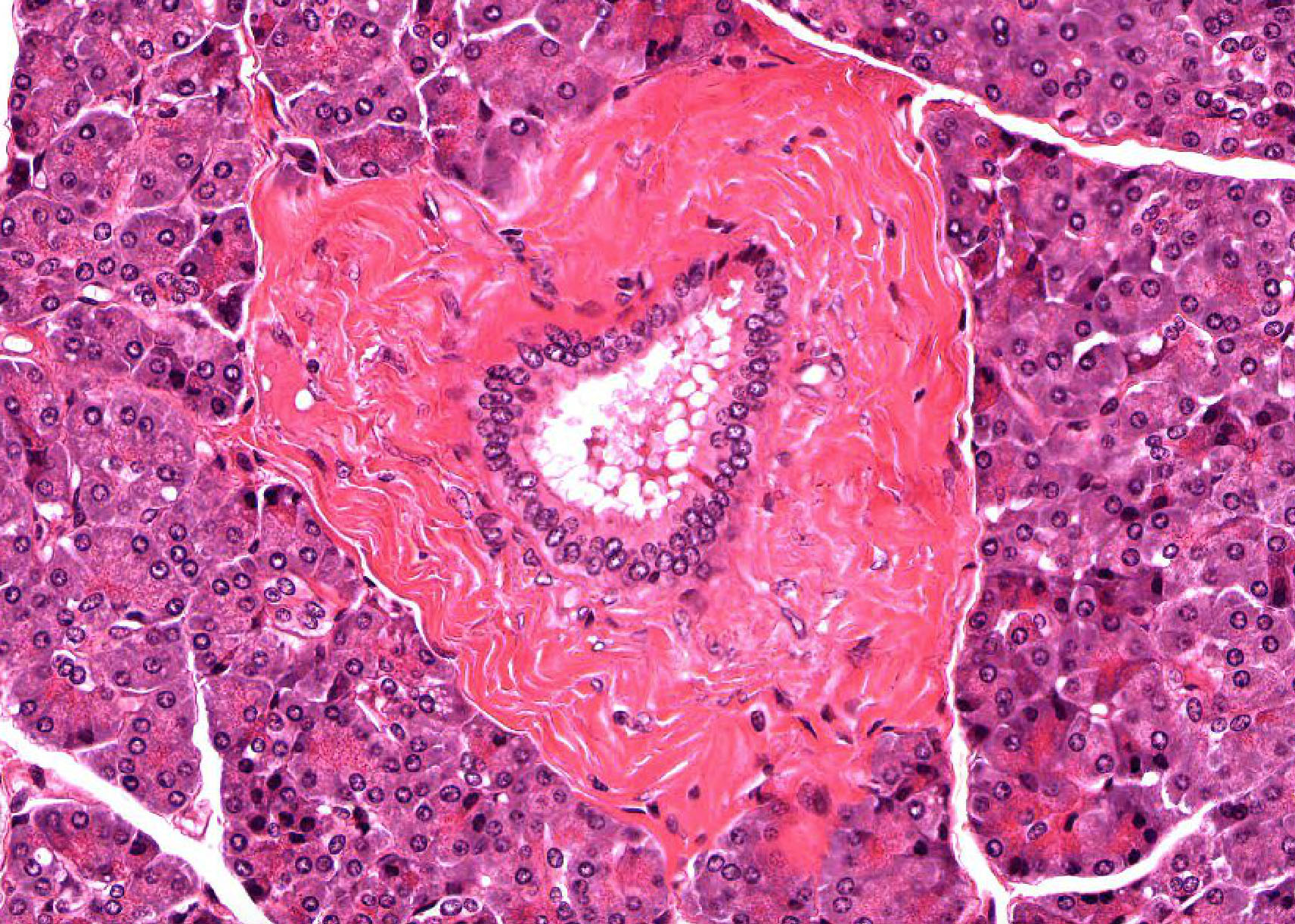



Pancreas Histology




Pancreas Anatomy Functions And Diseases Medical Library




Pancreas Wikipedia



Exocrine Pancreas Biochemistry Flashcards Draw It To Know It




Pancreas Physiology Intechopen



Chapter 16 Page 3 Histologyolm



Acinar Cells




Exocrine Cell Of Pancreas Electron Micrograph Labelling Diagram Quizlet
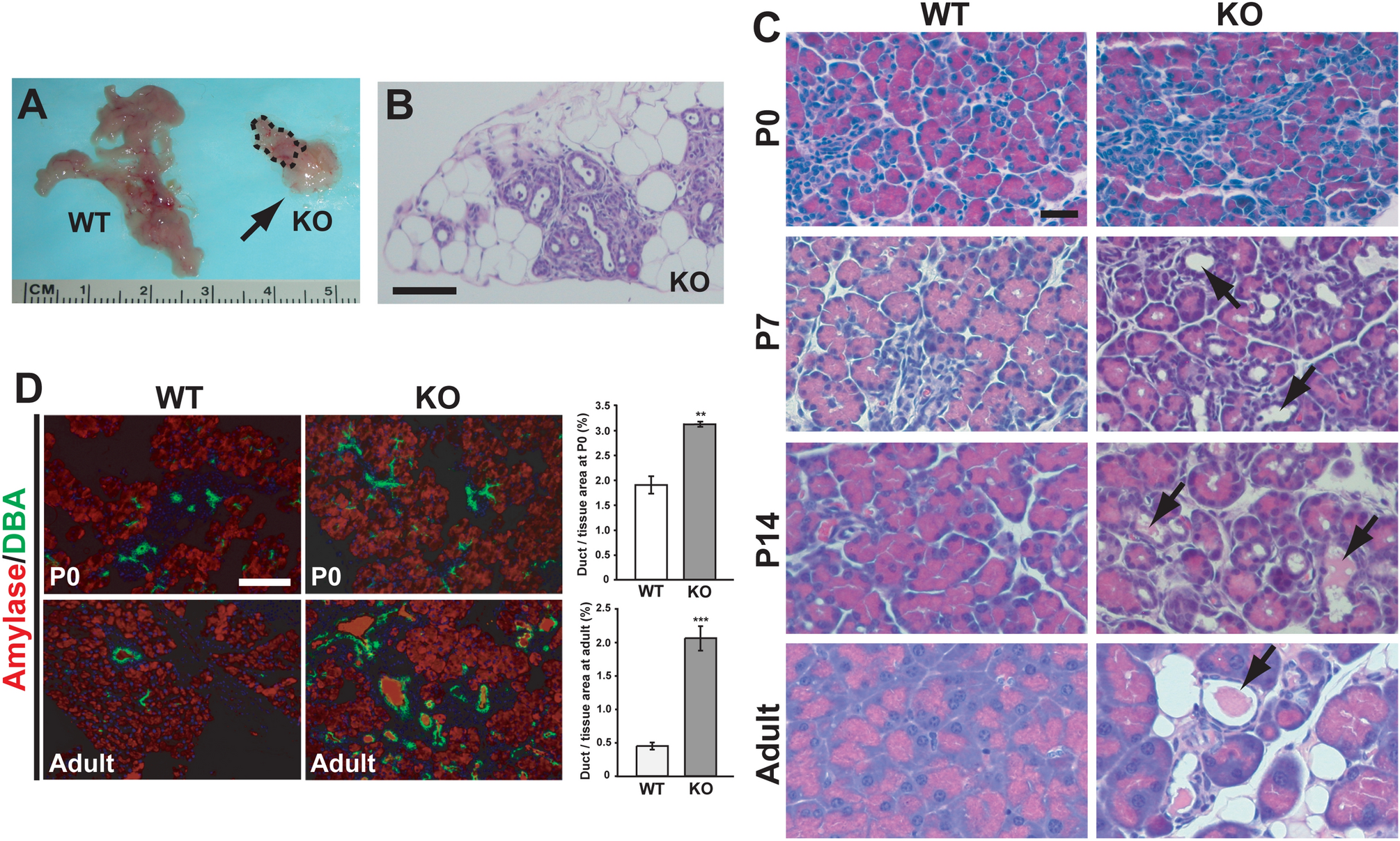



Loss Of The Ciliary Protein Chibby1 In Mice Leads To Exocrine Pancreatic Degeneration And Pancreatitis Scientific Reports




Pancreas




Liver Gall Bladder Pancreas



Anatomy 15 Virtual Microscopy




Integrated Pancreatic Blood Flow Bidirectional Microcirculation Between Endocrine And Exocrine Pancreas Diabetes



Liver And Pancreas
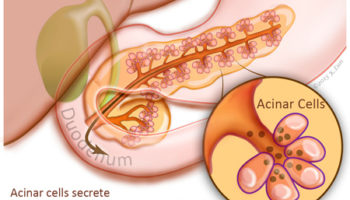



Pancreas Function Pancreatic Cancer Johns Hopkins Pathology




Pancreas Histology Boyar



Chapter 16 Page 3 Histologyolm




Histoquarterly Pancreas Histology Blog




The Ductal System Serving The Exocrine Pancreas Cross Sect Flickr




Normal Pancreas Pancreas Org Studying Medicine Histology Slides Medical Laboratory Science
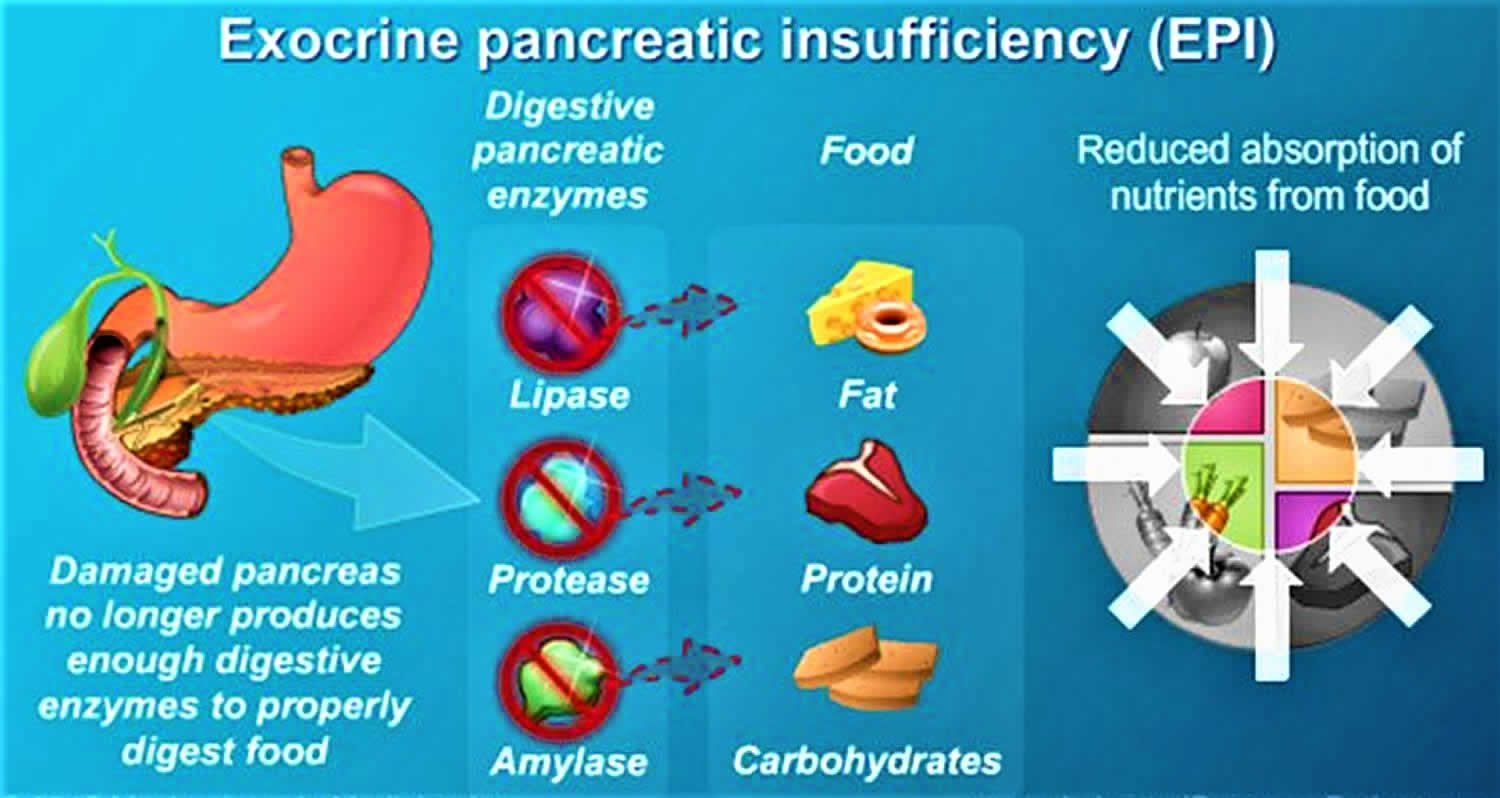



Exocrine Pancreatic Insufficiency Causes Symptoms Diagnosis Treatment



Pancreatic Histology Exocrine Tissue
:watermark(/images/watermark_only.png,0,0,0):watermark(/images/logo_url.png,-10,-10,0):format(jpeg)/images/anatomy_term/pancreatic-acinar-cells/86g1HQPABGT8iQy0zPdrpg_Exocrine_cell_of_pancreas.png)



Pancreas Histology Exocrine Endocrine Parts Function Kenhub




Exocrine Pancreas Cell Microscopic Photography Macro And Micro Microscopic



Anatomy 15 Virtual Microscopy
コメント
コメントを投稿